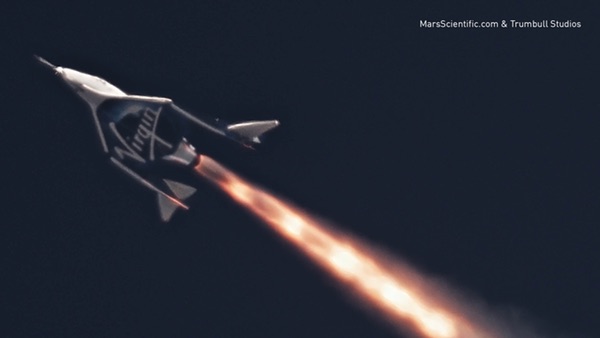SpaceShipTwo is a step closer to spaceby Jeff Foust
|
| “It also marks a key moment for the test flight program, entering now the exciting phase of powered flight and the expansion to full duration rocket burns,” the company said. |
On Thursday, Virgin Galactic’s second SpaceShipTwo, named VSS Unity, performed its first powered flight. Carried aloft by its WhiteKnightTwo aircraft, Unity was released in the skies above Mojave, California at around 9 am local time April 5, as it has on several previous glide flights dating back to December 2016.
This time, though, pilots Mark “Forger” Stucky and Dave Mackay ignited the vehicle’s hybrid rocket motor for a 30-second burn. On the flight, the vehicle reached a top speed of Mach 1.87 and altitude of more than 25,000 meters before gliding back to a runway landing at the Mojave Air and Space Port. A successful flight, in the eyes of Virgin Galactic.
“The flight has generated valuable data on flight, motor, and vehicle performance which our engineers will be reviewing,” the company said in a statement after the flight. “It also marks a key moment for the test flight program, entering now the exciting phase of powered flight and the expansion to full duration rocket burns.”
The powered flight had been a long time coming. As far back as last September the company hinted that powered test flights were soon to begin, but by the end of last year would only commit to beginning powered test flights some time in 2018.
“We’ve been doing a lot of work on the vehicle to be prepared for that phase of flight,” Virgin Galactic CEO George Whitesides said at a December suborbital research conference on the upcoming powered test flight campaign (see “2018 may (almost) be the year for commercial human suborbital spaceflight”, The Space Review, January 2, 2018). “We’re looking forward to having a full 2018 with powered test flights. That will be a very exciting phase for our company. We’re going to take our time to do it right.”
Whitesides and others at the company have not committed to a specific number, or even range, of powered test flights. This flight, though, was notable in that it was longer—and thus went faster and higher—than any of the powered test flights by the first SpaceShipTwo, VSS Enterprise, prior to its fatal accident on its fourth powered flight in October 2014.
Those future test flights will presumably feature longer burns, going higher and faster, but how gradual the envelope expansion will be isn’t clear. The fact that the first powered flight went longer than any of the ones with the first SpaceShipTwo suggests some aggressiveness in their flight test plan.
But how aggressive Virgin Galactic will be—or should be—is yet to be seen. It’s main competitor in suborbital human spaceflight, Blue Origin, has shown less urgency in its flight development program: it’s been about four months since the last New Shepard suborbital spaceflight from the company’s West Texas launch site. While the company has talked about flying people, at least company test pilots, on missions this year, they are in no rush to sell tickets for flights, let alone start commercial flights with people on board (see “A changing shade of Blue”, The Space Review, March 19, 2018).
| “Data review to come, then on to the next flight. Space feels tantalizingly close now,” said Branson. |
Blue Origin, though, can be patient: it has no backlog of customers for those flights yet (beyond research payloads it is already flying on suborbital test flights) and has a patient investor in Jeff Bezos. Moreover, suborbital spaceflight is likely to be never more than a small part of the company’s overall business. The average revenue from a single suborbital flight (on the order of $1–2 million, depending on ticket prices it charges) will be dozens of times smaller than what it’s likely to get from a single launch of its New Glenn orbital vehicle.
Virgin Galactic, though, is all-in when it comes to suborbital spaceflight, as its small launch vehicle program, LauncherOne, is now run by a separate company, Virgin Orbit. And some of its customers, who signed up more than a decade ago, are doubtless growing impatient given the extensive delays in SpaceShipTwo’s development.
The company also has investment pending from the Public Investment Fund (PIF) of Saudi Arabia, which announced a non-binding agreement in October to invest $1 billion into Virgin’s portfolio of space companies, with an option to invest nearly a half-billion more.
Neither PIF nor Virgin has announced if that agreement was finalized, but the head of the fund, Saudi Crown Prince Mohammad bin Salman Al-Saud, visited Virgin Galactic’s facilities in Mojave days before the flight as part of a U.S. tour. In images of that visit the logo for “Vision 2030”, a Saudi initiative that includes investment in new industries, was visible on the side of WhiteKnightTwo.
No one is more excited about getting SpaceShipTwo into space than Richard Branson. In a tweet he exclaimed that Virgin Galactic was “back on track” after that powered test flight. “Data review to come, then on to the next flight. Space feels tantalizingly close now.”
In a blog post, though, he was a little more cautious. “It was thrilling seeing our spaceship go supersonic for the first time, but we know there is a lot of hard work yet to come and lots of exciting days ahead.”
